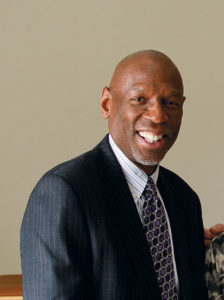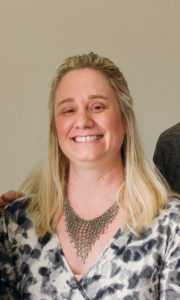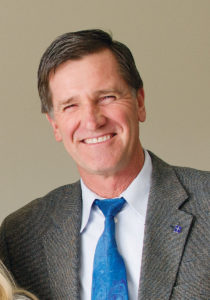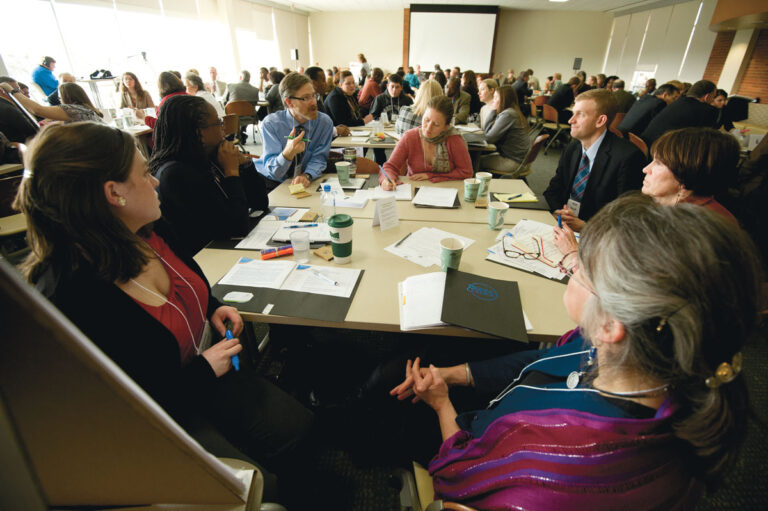
Geoff Canada might not be the first person one would expect to give the keynote address at a conference on issues facing rural America. He has spent most of his professional life as the director of the Harlem Children’s Zone (HCZ), a project that combines educational outreach and economic development, focusing on a 100-block area in Harlem, New York City. The success of HCZ led to its being used as a model for the creation of a federally funded program, Promise Neighborhoods, that helps communities develop a ‘cradle to career’ pipeline that supports all youth in achieving positive educational outcomes. As a result, he was invited to give the keynote address at the inaugural Rural Education Summit held on Berea College’s campus last fall.
In his address, Canada exhorted the participants to see past the superficial differences that divide urban and rural communities. If we want to know how to overcome poverty and improve education, he suggests asking the question without tying it to place: “There’s something about the ability to have solid education, real health care, a working support for you and your family, that just helps folk, and when people don’t have that, it seems like it really interferes with people.” He noted that impoverished members of both rural and urban communities often see school systems as foreign and even a little intimidating. Many parents had negative experiences when they were students and expect the same for their children. For both rural and urban communities, then, failing in school has become a part of an entrenched cultural expectation. As a result, Canada argues, “we’ve got to show kids that it is normal, right to do well in school. That it is normal.”

One group that has taken up this charge already is Partners for Education at Berea College, which in 2011 was one of five organizations chosen to implement the Promise Neighborhood approach and the only one selected from a rural area: the Berea neighborhood includes Clay, Jackson, and Owsley counties in eastern Kentucky. According to Executive Director of Partners for Education, Dreama Gentry, what makes Berea a natural fit with the Promise Neighborhoods model is a core of shared beliefs about community engagement and revitalization. “Like HCZ, we believe that this work must be done in partnership with the community and the families,” she said. ”You have to work together to support all young people, and education is the key.”
Making changes in cultural expectation will not be easy, and it will not happen quickly. Many steps and many hands will be required to make progress on the underlying problems. As Gentry noted, long-term success must be built on a solid base, and that means, “you have to lift the aspirations and build the academic skills, create the pathways and engage the families.” While there are many uncertainties about how to combat the social, educational, and economic ills that affect the area, one truth is clear: the problems must be tackled together for sustainable progress to be made.
No single event more clearly reflects this approach to the problems in the Appalachian region than the two-day Rural Education Summit itself, held on Berea’s campus in late November of 2013. The event had two purposes. First, it showcased the effectiveness of Berea’s Promise Neighborhood Initiative for addressing the issues facing rural America, particularly Appalachia. Second, the Summit offered participants the opportunity to share experiences, to compare strategies, and to offer mutual support. As one speaker noted, rural education advocates often work in isolation, and the community needs to find more ways to share accomplishments and support each other’s efforts in emotional and intellectual ways.[/text_output][image type=”none” float=”none” info=”popover” info_place=”top” info_trigger=”hover” src=”98″ alt=”Middle school students learned to piece together quilts alongside experts from the Jackson County community as part of Promise Neighborhood’s arts and humanities.” title=”Middle school students learned to piece together quilts alongside experts from the Jackson County community as part of Promise Neighborhood’s arts and humanities.” info_content=”Middle school students learned to piece together quilts alongside experts from the Jackson County community as part of Promise Neighborhood’s arts and humanities.”][text_output]On the Summit’s first day, participants had the opportunity to hear from foundations, government agencies, and other frontline service providers in an atmosphere that encouraged direct dialogue about long-term strategies and immediate applications. The morning session centered on facilitated table discussions. In groups of six to eight, the participants were asked to consider a particular issue or problem facing the region and to share perspectives and strategies for addressing the problem in the future. Summaries of these facilitated discussions will form the basis of a whitepaper being developed by Partners for Education. It is hoped that the paper will catalyze activities in the home communities of the participants and that it will help create opportunities for further collaboration.
However, many of the presenters at the Summit cautioned that this work has become increasingly difficult due to pressures on rural economies from job loss and diminished tax bases. Judy Owens of the Steele-Reese Foundation noted a disturbing trend: in the past, school systems would approach foundations to support supplemental programs like tutoring and other afterschool activities, but recently more and more requests are for core needs. She cited as an example a school system that requested funds to support a librarian to be shared between several schools in the system. Rhetorically, she asked, “When did it become okay for a school not to have its own librarian?”
In a similar vein, Kathy Spangler from Save the Children spoke of the additional day-to-day concerns rural schools face compared to their urban or suburban counterparts. Higher transportation costs, for example, further strain already limited budgets. She also noted the problems related to drug and alcohol abuse, the lack of a technically skilled workforce, and the paradoxical existence of “food deserts” in rural America, including Appalachia.
On the second day, participants had the opportunity to see how Partners for Education adapted the Harlem Children’s Zone’s cradle to career approach in rural Kentucky. One group of participants visited Jackson County High School to see how a partnership with the local school district has increased college and career readiness. A second group travelled to Clay County where they saw how Save the Children’s Early Steps to School Success (ESSS) program is strengthening the connection between the schools and homes of elementary students. A third shuttled between Owsley and Jackson counties where they learned about efforts to incorporate wellness, family engagement, and the arts into school curricula.
Ginny Ann Blackson, director of the Berea College Promise Neighborhood Initiative, said the Rural Education Summit achieved its goal. “We featured work that can be deepened or replicated in other rural areas,” she said. “The summit was intended to focus attention on the need for private investment in rural education and on policy changes needed to ease the programmatic and financial issues impacting education in rural America.”
What the Future Holds
Because the Promise Neighborhood model is based on collaboration and forming new alliances, it has opened many new avenues for Partners for Education. “Our philosophy is, go in and work with the community, determine who is already there doing the work, identify any gaps in services and work together on solutions,” said Gentry. In the weeks after the Summit concluded, the value of the partnership-oriented model was highlighted by Berea’s role in two very different programs.

Very shortly after the summit, it was announced that Berea would play a key role in the Promise Zones on a large scale, multi-partner, region-wide initiative intended to bolster the economy of an area comprised of Bell, Harlan, Letcher, Perry, Leslie, Clay, Knox, and part of Whitley county (see sidebar for more information). Berea College President Lyle Roelofs commented that the success of the initiative will require “the coordination of work across many dimensions, and data gathering and assessment to ensure that the desired results are achieved. Partners for Education has considerable expertise in coordinating this work, and I am very pleased that the Berea team will provide essential contributions to the Promise Zone initiative.”
A second result of Berea’s collaborative approach was the decision by Kentucky Governor Steven Beshear to hold a press conference at the Partners for Education home office, highlighting the efforts of the Kentucky Asset Success Initiative (KASI), which is dedicated to increasing individual access to the Earned Income Tax Credit (EITC), a refundable federal tax credit for low and middle-income working families and individuals. In 2013, Partners for Education became the convening agency for the Eastern Kentucky Asset Building Coalition, a KASI partner. Other KASI partners include the IRS, the United Way of Kentucky, Kentucky Domestic Violence Association, Community Action Kentucky, Department of Revenue, AARP Tax Aide, Central Kentucky Economic Empowerment Project, Louisville Asset Building Coalition, Green River Asset Building Coalition, Barren River Asset Building Coalition, Northern Kentucky Asset Building Coalition, Northeast Kentucky Asset Building Coalition and the Purchase Area Asset Building Coalition.
The impact the EITC can have on individual families and on our communities is significant and quantifiable. In 2013, 401,000 Kentuckians applied for the EITC and received an average credit of $2,299. Beshear noted that “97 percent of the money returned to our families because of this credit is spent right back in our communities. It is spent with our local businesses for food, for shelter, for clothing, for transportation.”
Lacy Adams, who has volunteered with KASI to help others complete the paperwork for the EITC, spoke of the great impact the extra money can have on a working class family: “I have prepared many tax returns over the four years I have participated in the VITA [Volunteer Income Tax Assistance] program, and I can tell you that this program changes lives. I had one client tell me they had been diagnosed with cancer in the previous year, and the money could be spent for their medical expenses or to file their taxes. Other clients are so grateful for the refund they will receive because they can now afford to fix the roof that is leaking or the porch that has fallen in.” In other cases, the EITC money can be the difference between taking a part-time class at a local community college or technical school.
The experience gained with programs ranging from the Promise Neighborhoods and Promise Zones to the EITC will help further the discussion about the future of rural America at the next Summit. The Rural Education Summit is intended to be a bi-annual event, so plans are already being made for the next iteration in 2015. For more information, please see the Partners for Education website at www.partners.berea.edu.[/text_output][blockquote type=”left”]According to a White House press sheet, the key South-eastern Kentucky Promise Zones strategies include:
Implementing a sustainable economic effort across eight counties in the Kentucky Highlands region, focused on diversifying Southeastern Kentucky’s economy to make it more resilient.
Creating jobs and growing small businesses by leveraging $1.3 million of private sector funds in a revolving loan fund targeted within the Promise Zone.
Creating leadership and entrepreneur training for youth and industry-specific re-training opportunities for local skilled workforce, through the University of Kentucky Economic Development Initiative, the East Kentucky Concentrated Employment Program, and the Kentucky Highlands Investment Corporation.
In order to ensure all youth have access to a high-quality education, Berea College will run evidence-based college and career readiness programs for high school students in the Zone, while Eastern Kentucky University will expand technical education programs.


